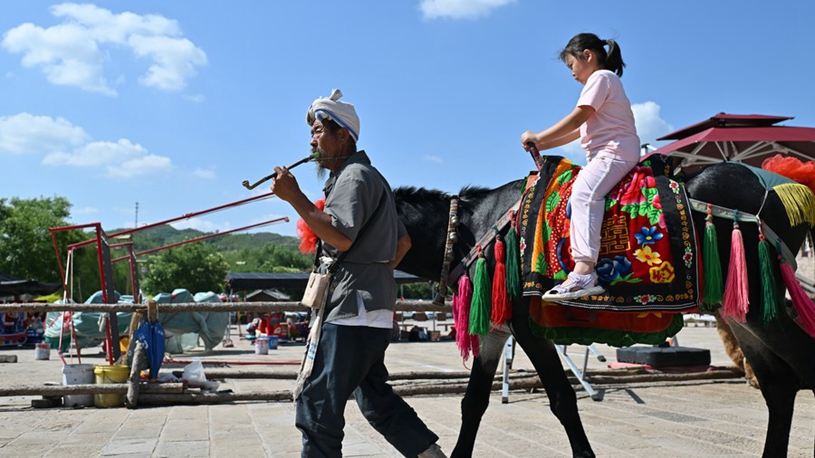
This aerial photo taken on Sept. 30, 2023 shows a high-speed electric multiple unit (EMU) train of the Jakarta-Bandung High-Speed Railway running in Purwakarta, Indonesia. (Xinhua/Xu Qin)
BEIJING, Oct. 3 (Xinhua) -- The Jakarta-Bandung High-speed Railway, which links Jakarta, the capital of Indonesia, and Bandung, a famous tourist city, officially opened on Monday.
As a landmark project of the Belt and Road Initiative and cooperation between China and Indonesia, it shortens the train trip between Jakarta and Bandung from more than three hours to about 40 minutes via this new 142.3-km line.
"The Jakarta-Bandung High-Speed Railway will make transportation between major cities in Indonesia more convenient, and will stimulate economic development and employment along the railway, which is of great significance to the Indonesian people," said Ai Bo, dean of the School of Electronic and Information Engineering, Beijing Jiaotong University.
As a Chinese expert in the field of rail transit control and safety, Ai has deep feelings for the Jakarta-Bandung High-speed Railway.
From September 2017 to January 2022, Beijing Jiaotong University cooperated with ZTE, China Railway Design Corporation, Institut Teknologi Bandung (ITB), Technische Universitat Braunschweig, University of Birmingham and other domestic and foreign enterprises and institutions, to ensure the safe operation of the Jakarta-Bandung High-speed Railway.
The international sci-tech cooperation project "Research and Pilot Application of Mobile Communication Network Theory and Technology for High-speed Railways in Indonesia" was jointly carried out, with Ai as the project leader.
"The communication system ensures the safe running of the train operation control system, which is like the brain of the train," said Ai in explaining the team's work from his office at Beijing Jiaotong University.
"High-speed railways require special communication networks to transmit safety information, such as train operation control, traffic permission, train speed and location," he added.
The most critical point in mobile communication is the transmission and reception of electromagnetic waves. Geographic and environmental factors such as topography and climate affect the channel, or the path of electromagnetic wave transmission. For example, landforms along the railway, such as tropical rainforests, can affect the channel.
Considering the unique local terrain and working frequency bands in Indonesia, Ai led his research team to develop a high-performance ray-tracing simulation platform driven by channel simulator and parallel computing.
Over the years, faculties and students from Beijing Jiaotong University traveled along the Jakarta-Bandung High-Speed Railway route, using wireless channel simulators and ray tracing toolboxes to emit and track electromagnetic rays, collecting signal data to reconstruct the railway's environment and establish a suitable local channel model.
After establishing the new channel model, the model had to be evaluated and verified using software and algorithms to ensure its accuracy for high-speed railway application. Thus, the research team also created a simulation verification platform.
"This platform can simulate the operating environment of high-speed trains with speeds of up to 500 kilometers per hour, frequencies exceeding 100 GHz, and over a thousand antenna arrays. It combines physical elements to better replicate real-world conditions, ensuring the safe operation of trains in a real environment," Ai said.
Through this high-speed railway project, a group of local tech talents engaged in research and development were trained in Indonesia, driving employment and providing intellectual support for the local economy, according to Ai.
The project also provided a solid cooperative platform for China-Indonesia scientific research and talent cultivation.
During the project, over 20 teachers and students from ITB visited Beijing Jiaotong University for training and exchanges. The two universities jointly trained four students at either master's or doctoral level, and co-organized several international academic seminars, and published more than ten high-level research papers.
ITB student Selvi Lukman completed her doctoral studies this July, with Ai as one of her supervisors. She participated in mobile communication development for the Jakarta-Bandung High-Speed Railway project. Her doctoral dissertation was mainly focused on channel modeling for railway communication.
"I am proud to have been involved in this significant contribution of high-speed rail technology in the field of wireless communication," said Lukman, who witnessed the entire development of the communication network project.
"In the past, Indonesia's transportation infrastructure was underdeveloped. With the opening of the Jakarta-Bandung High-Speed Railway, Indonesia will become the first Southeast Asian country with a functional high-speed railway," Lukman added.
Lukman is now lecturing at Maranatha Christian University in Indonesia following her graduation. She hopes to continue in-depth research in the field of high-speed railway communication systems and become an expert in the future.
"The opening of the Jakarta-Bandung High-Speed Railway is a good start," Ai said, "I'm looking forward to more advanced Chinese technologies going global and benefiting the Belt and Road countries, which will definitely enhance our cooperation and friendship." ■












